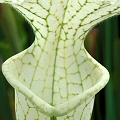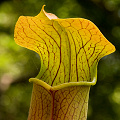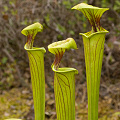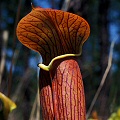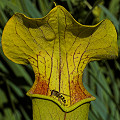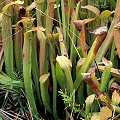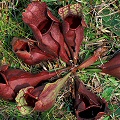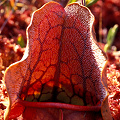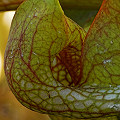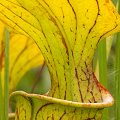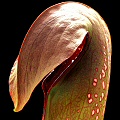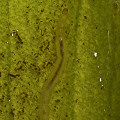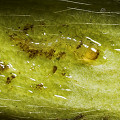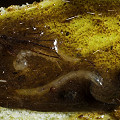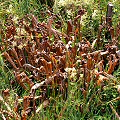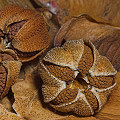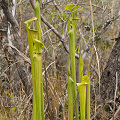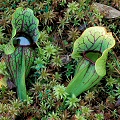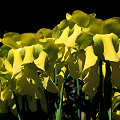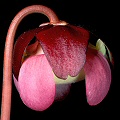Q: Introducing the North American pitcher plants
A: As you might guess from my domain name, I am very fond of the genus
Sarracenia. Yes, my publication history and scientific research suggests I am
most strongly focused on Utricularia, but this is partly a matter of geographic opportunity. When I am at field-sites that have Sarracenia, they mesmerize me. Why shouldn't they? They are spectacular plants!
For the most part, Sarracenia is a genus of passive pitcher plant carnivores restricted to the
southeastern USA, although one species ranges far north and west into Canada.
Most of the species have erect and tubular pitchers. The pitchers are modified leaves. Insects are
attracted to the pitchers because they mimic flowers---the pitchers are brightly colored, and are endowed with sugar-exuding glands
called extrafloral nectaries (i.e. nectar sites that are not in flowers). It is significant that the pitcher coloration and
distribution of nectaries are usually strongest near the pitcher opening---a dangerous place for incoming insects!
Some people have noted that Sarracenia pitchers often exude a smell, usually because of the rotting
insects trapped in the pitchers. I have examined many Sarracenia pitchers
in the field, and
very few had a strong stink from prey. Those that do are usually overloaded by excessive prey, and are in fact suffering
pitcher damage from their rotting contents. Although I do not think that Sarracenia
pitchers typically have a rank odor, there is no question that the pitchers of
Sarracenia leucophylla often have a faint, somewhat minty smell. It would be very interesting if
people were to study this further. And bear in mind that the smells that humans notice are not necessarily the ones that matter to insects!
But I digress--let me return to the general trapping mechanism. Crawling insects make their way from the ground up to the pitcher
opening, where they greedily dine on the large number of sugary secretions on the pitcher lip.
Some theorize that the flange running along the front of the pitcher tube, from the ground to the pitcher mouth, may act as
a path for crawling insects, but I have not observed this in the wild. Having reached the pitcher mouth, creeping animals are at
great risk of falling into the pitcher, and this is of course what happens to a certain, small fraction of
the visitors.
Meanwhile, flying
insects usually land on either the pitcher lip or, very frequently, on the pitcher lid. Indeed, I believe that the primary function
of the pitcher lid is that of a convenient landing pad---it is brightly colored and is often the most attractive part of the
leaf. The nectar glands on the top surface of the lid are most densely distributed along its edge, tempting the
foraging insects to the lid's circumference. There are even more nectar glands on the
underside of the lid, so soon the insects find themselves dining in a most precarious and dangerous place---hanging
upside down, directly over the plant's maw.
Despite common misperception, the lid on erect species does not slap closed on prey. The lid functions as a landing pad and probably also as a
rain shield to protect the pitcher from being overfilled by rainwater.
Bugs that fall into the pitchers are in serious trouble, as the inner surface of the pitcher is extremely slippery. Furthermore,
it is a narrow, erect tube so flying insects (most of which do the majority of their flying laterally, instead of hovering)
crash back and forth into the pitcher walls and, loosing control, they
career into the pitcher depths. Deeper into the pitcher, downward-pointing
hairs on the pitcher walls prevent escape by those prey that try to climb to freedom.
The bottom of the pitchers is filled with fluid (sometimes lacking in plants cultivated in less-ideal conditions). These
fluids are filled with digestive enzymes, although I do not know if this has been verified for all species, and also a great
number of hungry creatures ranging from bacteria to the larvae of mosquitoes
(especially Wyeomyia smithii), midges (i.e., Metriocnemus knabi),
or flesh flies (such as Sarcophaga sarraceniae). These help consume and digest the captured prey.
This is just an introduction to what is a much more complicated situation. In the various species profiles on the following web pages in this section, I
will point out variations on the basic description I have given above.
There is a certain amount of literature on the presence of the paralyzing agent coniine in the pitchers of
Sarracenia flava. Anecdotal observations of cultivated plants show they can paralyze ants, and
the compound has indeed been isolated in S. flava pitcher fluids.
Sarracenia plants have an interesting life cycle. They germinate, usually in the spring, and after producing
a pair of cotyledons (seedling leaves), they immediately begin building tiny pitchers that look like miniature versions of
Sarracenia minor. Subsequent pitchers are larger and larger as the plant grows. By the arrival of
winter, the plants may be a few centimeters (about an inch) tall. After a pause for winter, the plants resume growth in the
spring. Repeat, repeat, repeat the process for a few years, and eventually the plants reach maturity.
A mature plant in mid-winter often looks old and miserable. Its pitchers are
tattered by a long season of work, or may be burned back by fires. With the resumption of spring growth,
the first thing the plant does is make flowers. These flowers are harmless to insects, and even reward pollinators with
pollen and nectar just as conventional, insect-pollinated flowers usually do. Once pollination is over, the plant produces its
new crop of
carnivorous pitchers as it shifts its relationship with insects from kindly to cruel. It eats bugs all summer long until the
pitchers die back in the fall. As the pitchers shrivel, they
translocate nutrients from the leaves back to the underground rhizome. Meanwhile, the
fruit on the flowers split open, and scatter seed.
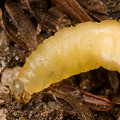 Wasp larva
Wasp larva
in S. jonesii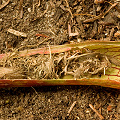 Wasp nest
Wasp nest
in S. jonesii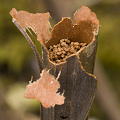 S. flava
S. flava
pitcher damage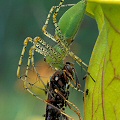 S. flava
S. flava
& green lynx spider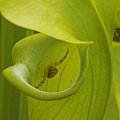 S. alata
S. alata
& crab spider
Most species of Sarracenia live in the semi-tropics of the USA. As you should expect for such a
biologically diverse region, there are many insects
that have learned how to capitalize on the special attributes of
Sarracenia. I have already mentioned insects that live inside the pitcher fluid and probably
benefit the plant.
But there are also insects that live inside the pitchers, above the fluid line,
and damage them by feasting upon their tissues. The larvae of three species of Exyra moths
eat the pitcher walls, causing the top of the pitcher to topple over.
Exyra rolandiana feasts only upon S. purpurea,
Exyra ridingsii eats S. flava, and
Exyra semicrocea infests the other species. The wasp
Isodontia philadelphicus commandeers the pitchers of many Sarracenia
species to house its developing grub. This wasp plugs the pitcher tube, rendering the plant unable to feed.
Insects do not restrict their activities to the pitchers.
Larvae of the moth Papaipema appasionata bore into the rhizomes of many
Sarracenia species and cause great damage, often killing the plant.
I have also seen many fruit of Sarracenia purpurea in New Jersey destroyed,
apparently by the larvae of the moth Endothenia daeckeana. Very interesting.
The name Sarracenia was coined by Linnaeus to honor Michel Sarrazin, a Quebec botanist and
surgeon. Common names for the genus abound. The most common of the common are "pitcher plants",
"North American pitcher plants", and "trumpet pitchers" (the last being applicable to only the tall and tubular
species). Regional common names include "frog's britches", "huntsman's horn" (both probably
for Sarracenia purpurea), and "fly bugles."
Some common names are derived from the flowers. A flower viewed from below (especially after petal-fall)
looks rather like a pocket watch without dial markers or hands, and is therefore unable to tell you the time, earning it
the name "dumb watches." Meanwhile, flowers with red petals can look like a cup overflowing with dripping red fluid,
resulting in the name "blood cups" (which I like a lot). Yellow-flowered plants are analogously called
"butter cups," which is nice except that this name is more widely applied to a large number of wetland wildflowers in
the genus Ranunculus.
Page citations: Juniper, B.E. et al. 1989;
McPherson, S. & Schnell, D. 2011;
Mody, N.V. et al. 1976; Rice, B.A. 2006a;
Schnell D.E. 1976, 2002a.
